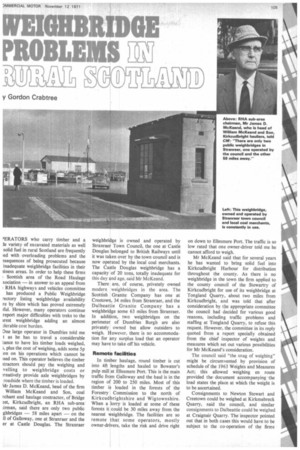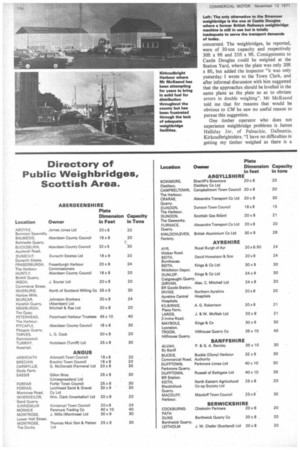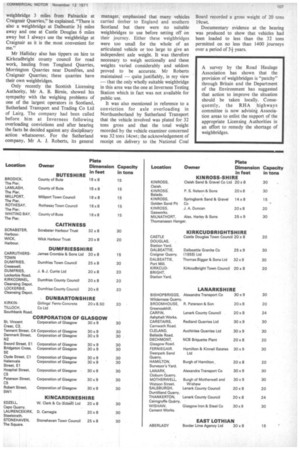WEICIIIBREDGE
Page 107

Page 108

Page 109

If you've noticed an error in this article please click here to report it so we can fix it.
PROBLEMS EZ
110naffl
y Gordon Crabtree
'ERATORS who carry timber and a ie variety of excavated materials as well solid fuel in rural Scotland are frequently ed with overloading problems and the isequences of being prosecuted because inadequate weighbridge facilities in their siness areas. In order to help these firms Scottish area of the Road Haulage sociation — in answer to an appeal from RHA highways and vehicles committee has produced a Public Weighbridge -ectory listing weighbridge availability re by shire which has proved extremely :NI. However, many operators continue report major difficulties with treks to the west weighbridge adding an almost plerable cost burden.
Dne large operator in Dumfries told me t as he has to travel a considerable twice to have his timber loads weighed, ;, plus the cost of weighing, adds some 5p on on his operations which cannot be ised on. This operator believes the timber 'tractors should pay the weighing and yelling to weighbridge costs or :rnatiyely provide axle weighbridges by
roadside where the timber is loaded.
Vir James D. McKeand, head of the firm William Mc Keand and Son, coal rchant and haulage contractor, of Bridge ;iet, Kirkcudbright, an RHA sub-area .irman, said there are only two public ghbridges — 58 miles apart — on the 11 of Galloway, one at Stranraer and the er at Castle Douglas. The Stranraer weighbridge is owned and operated by Stranraer Town Council, the one at Castle Douglas belonged to British Railways until it was taken over by the town council and is now operated by the local coal merchants. The Castle Douglas weighbridge has a capacity of 20 tons, totally inadequate for this day and age. said Mr McKeand.
There are, of course, privately owned modern weighbridges in the area. The Scottish Granite Company has one at Creetown, 34 miles from Stranraer. and the Dalbeattie Granite Company has a weighbridge some 63 miles from Stranraer. In addition, two weighbridges on the perimeter of Dumfries Burgh are also privately owned but allow outsiders to weigh. However, there is no accommodation for any surplus load that an operator may have to take off his vehicle.
Remote facilities
In timber haulage. round timber is cut into 4ft lengths and hauled to Bowater's pulp mill at Ellesmere Port. This is the main traffic from Galloway and the haul is in the region of 200 to 250 miles. Most of this timber is loaded in the forests of the Forestry Commission to the north of Kirkcudbrightshire and Wigtownshire. When a lorry is loaded at some of these forests it could be 30 miles away from the nearest weighbridge. The facilities are so remote that some operators, mostly owner-drivers, take the risk and drive right on down to Ellesmere Port. The traffic is so low rated that one owner-driver told me he cannot afford to weigh.
Mr McKeand said that for several years he has wanted to bring solid fuel into Kirkcudbright Harbour for distribution throughout the county. As there is no weighbridge in the town the firm applied to the county council of the Stewartry of Kirkcudbright for use of its weighbridge at Tongland Quarry, about two miles from Kirkcudbright. and was told that after consideration by the appropriate committee the council had decided for various good reasons, including traffic problems and staffing at Tongland Quarry, to refuse this request. However, the committee in its reply quoted from a report specially obtained from the chief inspector of weights and measures which set out various possibilities for Mr McKeand's consideration.
The council said "the snag of weighing" might be circumvented by provision of schedule of the 1963 Weights and Measures Act; this allowed weighing en route provided the document accompanying the load states the place at which the weight is to be ascertained.
Consignments to Newton Stewart and Creetown could be weighed at Kirkmabreck Quarry, said the council, and similar consignments to Dalbeattie could be weighed at Craignair Quarry. The inspector pointed out that in both cases this would have to be subject to the co-operation of the firms
concerned. The weighbridges, he reported, were of 30-ton capacity and respectively 30ft x 9ft and 25ft x 9ft. Consignments to Castle Douglas could be weighed at the Station Yard, where the plate was only 20ft x 8ft, but added the inspector "it was only yesterday I wrote to the Town Clerk, and after informal discussion with him suggested that the approaches should be levelled in the same plane as the plate so as to obviate errors in double weighing". Mr McKeand told me that for reasons that would be obvious to CM he saw no useful reason to pursue this suggestion.
One timber operator who does not experience weighbridge problems is James Halliday Jnr, of Palnackie. Dalbeattie. Kirkcudbrightshire. "I have no difficulties in getting my timber weighed as there is a
weighbridge 3 miles from Palnackie at Craignair Quarries," he explained. "There is also a weighbridge at Dalbeattie 3f miles away and one at Castle Douglas 6 miles away but 1 always use the weighbridge at Craignair as it is the most convenient for me."
Mr Halliday also has tippers on hire to Kirkcudbright county council for road work, hauling from Tongland Quarries, Morrington Quarries near Dumfries, and Craignair Quarries; these quarries have their own weighbridges.
Only recently the Scottish Licensing Authority, Mr A. B. Birnie, showed his sympathy with the weighing problems of one of the largest operators in Scotland, Sutherland Transport and Trading Co Ltd of Lairg. The company had been called before him at Inverness following overloading convictions and after hearing the facts he decided against any disciplinary action whatsoever. For the Sutherland company, Mr A. J. Roberts, its general
manager, emphasized that many vehicles carried timber to England and southern Scotland but there were no suitable weighbridges to use before setting off on their journey. Either these weighbridges were too small for the whole of an articulated vehicle or too large to give an independent axle weight. It was therefore necessary to weigh sectionally and these weights varied considerably and seldom proved to be accurate. Mr Roberts maintained — quite justifiably, in my view — that the only wholly suitable weighbridge in this area was the one at Inverness Testing Station which in fact was not available for public use.
It was also mentioned in reference to a conviction for axle overloading in Northumberland by Sutherland Transport that the vehicle involved was plated for 32 tons gross and that the total weight recorded by the vehicle examiner concerned was 32 tons 14cwt; the acknowledgement of receipt on delivery to the National Coal Board recorded a gross weight of 20 tons 19cwt.
Documentary evidence at the hearing was produced to show that vehicles had been loaded to less than the 32 tons permitted on no less than 1400 journeys over a period of 31 years.










































































































































































































